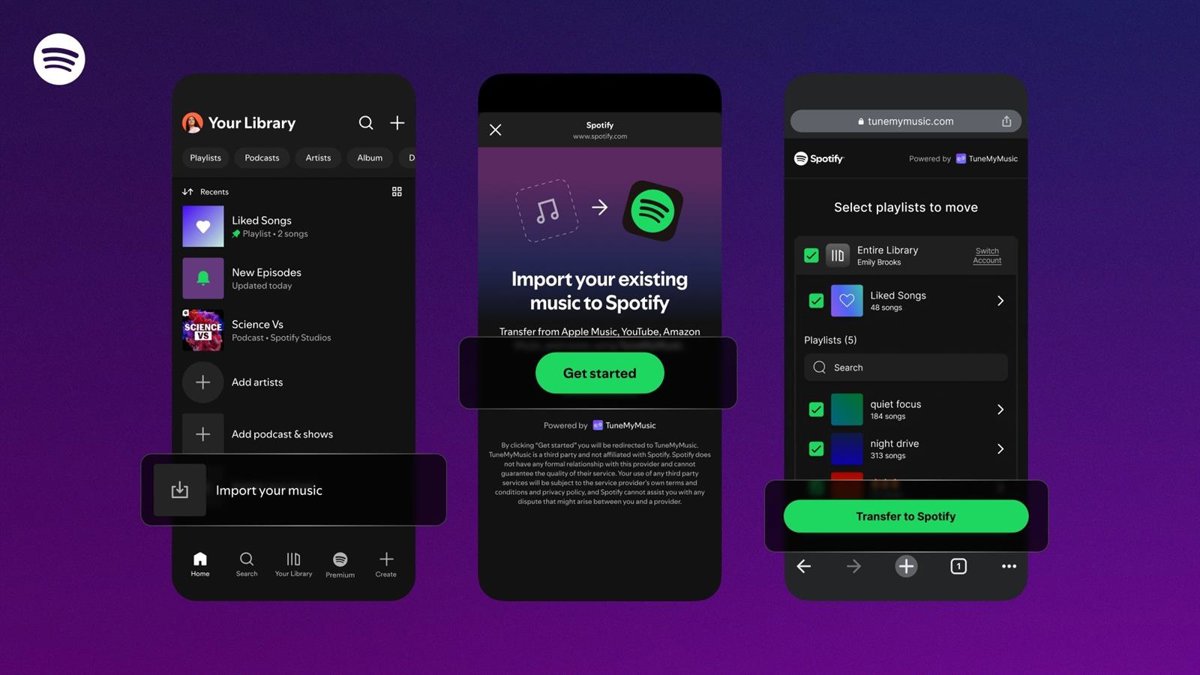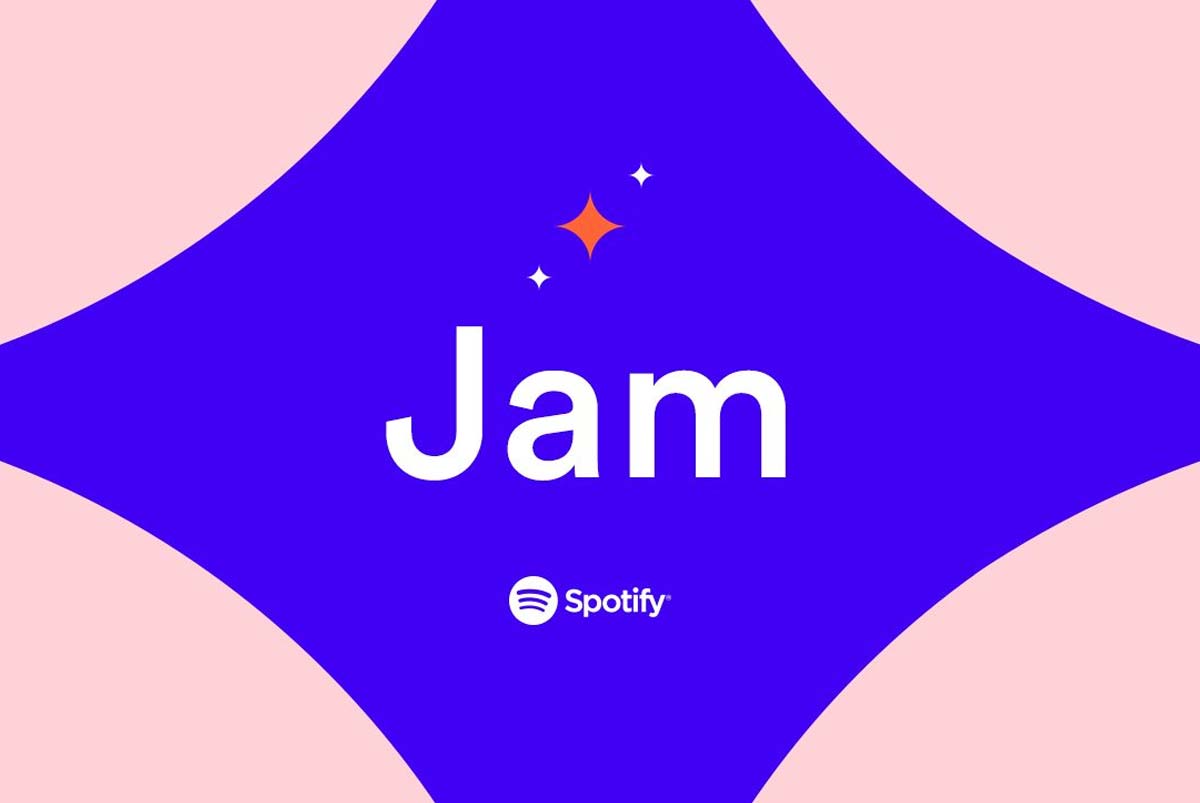- Spotify allows you to import playlists from other music streaming services directly from the mobile app.
- The official integration with TuneMyMusic makes it easy to migrate playlists from Apple Music, YouTube Music, Tidal, or Amazon Music, among others.
- Copied playlists are added to the Spotify library and improve the personalized recommendation system.
- Once imported, playlists can be customized, shared, and used with advanced features such as smart filters, Jam, or Lossless sound.

The way we listen to music has completely changed: now we wear All our playlists in your pocketJumping from one device to another effortlessly. In this context, losing playlists when switching platforms was one of the biggest fears of many users considering leaving their current service to switch to Spotify.
To tackle this problem, the company has begun deploying a new feature focused on Spotify playlists which allows importingIn just a few steps, music collections created on other streaming servicesThe goal is clear: that Anyone can move to the platform without giving up years of saved music and without having to rebuild anything from scratch.
Import your playlists to Spotify without external tools

Until now, anyone wanting to move their playlists to Spotify had to resort to third-party solutions, often with limitations on the number of songs or the length of the playlistsSome services imposed limits on the free version or required paid subscriptions to move large libraries, making the platform change quite cumbersome.
Spotify has decided to directly integrate the technology of TuneMyMusic, a service specializing in transferring playlists between music streaming platforms such as Apple Music, YouTube Music, Tidal, Amazon Music, Deezer, SoundCloud, or even Pandora. This way, the process is carried out directly from the Spotify interface, without needing to download additional apps or open external websites.
This tool, which is deploying globally on Android and iOS smartphonesIt appears under the name “Import your music” within the “Your library” section. Although TuneMyMusic remains the engine that powers the playlists, the user experience is practically native: everything is done without leaving the app and by following a guided assistant.
It is worth noting, however, that the system works. only in one direction: from other services to SpotifyThe platform does not offer an equivalent function for exporting playlists, so all official tools are geared towards bringing libraries into the Spotify ecosystem, not removing them.
How to use the “Import your music” function step by step

The process designed by Spotify aims to be as simple as possible so that any user, even one not used to tinkering with settings, can Transfer your playlists to Spotify without complicationsIn practice, you only need to follow a few steps from your mobile phone.
First, open the application and access the section “Your library”, located at the bottom of the screenOnce inside, you have to scroll down until you find the new "Import your music" option, which appears at the end of the list of available collections and filters.
Clicking on that option opens an integrated browser that loads the TuneMyMusic interface, but without leaving Spotify. From there, the user must choose the source platform for your lists (for example, Apple Music, YouTube Music, Amazon Music, Tidal or Deezer) and grant the necessary permissions so that the service can read the playlists stored in that account.
Once the connection is authorized, the tool displays the available lists and allows Select only those you want to copy to SpotifyAfter confirming the selection, the transfer begins: the application creates copies of those playlists in the user's library, while keeping the originals intact in the source service.
Depending on the number of songs and the length of the lists, the process can take from a few seconds to several minutes, but the user doesn't have to do anything else. When finished, the playlists appear in the Spotify library as if they had been created directly on the platform., ready to be played and edited normally.
Advantages compared to external tools

The big difference compared to traditional solutions is that now The transfer of playlists to Spotify is done through an official, integrated, and frictionless workflow.Previously, users had to find services like TuneMyMusic, Soundiiz, or SongShift on their own, grant permissions on external websites, and, in many cases, accept limits on the number of songs that could be copied without paying.
With the new integration, Spotify offers privileged access You can transfer music to TuneMyMusic directly from their app, which eliminates many of those obstacles. The company emphasizes that transfers to their platform are done without the usual restrictions on the number or length of playlists, something especially relevant for those who have been building up long playlists for years on different services.
Another key advantage is that the operation is done in copy mode: The lists are not deleted or modified on the original platformThis allows you to maintain parallel accounts on several services without fear of losing anything, so the user can try Spotify with their entire library already available, while keeping their collections intact on Apple Music, YouTube Music or other competitors.
From a user experience perspective, the integration also simplifies technical support. Since it's an officially announced feature, Spotify assumes some responsibility for the proper functioning of the process.This did not happen when everything depended on external services with no direct link to the company.
Customizing playlists in Spotify after importing
Once the collections have been migrated, Spotify encourages users to give them their own touch within the platformImported playlists support the same customization options as any list created from scratch, opening the door to adapting them to the app's environment without losing their original essence.
Among the most striking options is the possibility of design custom covers For each playlist, you can replace the generic image with a custom cover. This allows you to easily distinguish your most important playlists, better organize your library, and add a personal touch to your collection—something many users appreciate when sharing music with friends or family.
Functions related to reproductive control are also retained, such as the transition settings between songs (crossfade) to blend one track into the next, or options for random mixing, repeat, and track order management. Imported playlists can be freely edited: add or remove songs, change titles and descriptions, or rearrange tracks according to the time or intended use.
At the most advanced level, Premium subscribers have access to Smart filters that help update lists dynamicallyAdding suggestions that fit the playlist's predominant style is useful for keeping playlists from other services fresh, incorporating new releases from similar artists or recent songs that might not have been included when the original collection was created.
All of this is combined with flexible privacy management: each playlist can be marked as public, default or privateso that the user decides at all times which lists they want to show on their profile and which ones they prefer to keep just for themselves, even if they come from other platforms.
Social Functions, Jam Sessions, and Joint Listening

Spotify's commitment to playlists isn't limited to the technical aspects. The company has also strengthened the social tools associated with playlistsThis is especially relevant in Spain and Europe, where sharing music remains a widespread habit among friends and work or study groups.
Imported lists can be converted into collaborative playlists using the same steps as any other: simply Activate collaboration and share the link so that other people can add, rearrange, or remove songs. This makes it easy, for example, for an old playlist created in another app to become the shared soundtrack for a WhatsApp group, a club, or a work team.
Spotify has also promoted the feature Jam, designed to start real-time listening sessions among several users. Although it is mainly aimed at those with a Premium subscription, it allows several people to connect to the same playback queue, add tracks and vote on what is playing, either each from their mobile phone or by sharing a compatible speaker.
As for more informal exchanges, the app facilitates share playlists via messaging appssocial media or direct links, so that any playlist (including imported ones) can be shared quickly. This includes collections brought in from Apple Music, YouTube Music, or Tidal, which behave as if they were created on Spotify when sent via chat or posted on social media.
This social component fits with the platform's strategy of strengthening the community aspect around the playlists. The idea is that not only serve as a personal music archivebut also as a meeting point for users who share tastes, both in Spain and in other European countries where the app has a prominent presence.
With the arrival of direct playlist import, the platform takes an important step for those who hesitated to switch for fear of losing years of musical selection: now it's possible gather playlists scattered between Apple Music, YouTube Music, Tidal or Amazon Music on Spotify, take advantage of them to refine recommendations, personalize them with new creative tools and share them with friends, all without rebuilding the library from scratch or giving up the collections that were already in other services.
I am a technology enthusiast who has turned his "geek" interests into a profession. I have spent more than 10 years of my life using cutting-edge technology and tinkering with all kinds of programs out of pure curiosity. Now I have specialized in computer technology and video games. This is because for more than 5 years I have been writing for various websites on technology and video games, creating articles that seek to give you the information you need in a language that is understandable to everyone.
If you have any questions, my knowledge ranges from everything related to the Windows operating system as well as Android for mobile phones. And my commitment is to you, I am always willing to spend a few minutes and help you resolve any questions you may have in this internet world.
